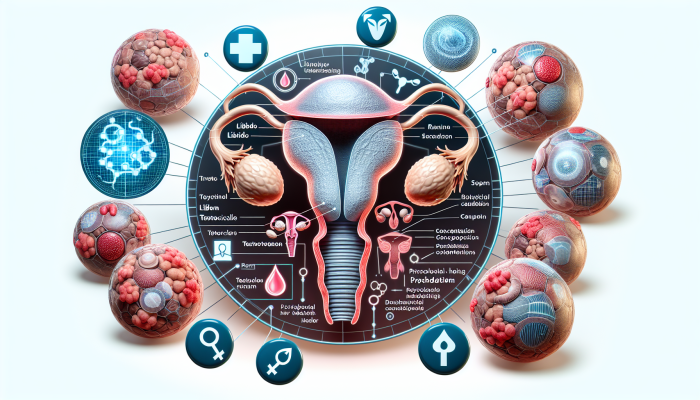Comprehensive Guide to Understanding Testosterone Testing Standards for Optimal Health
Testosterone is a fundamental element of hormonal health, essential for both men and women. This steroid hormone plays a critical role in fostering muscle growth, increasing sexual desire, maintaining bone density, and promoting emotional stability. Achieving the ideal balance of testosterone levels can markedly enhance one's quality of life, positively impacting energy levels, mood stability, and cognitive functions. Thus, grasping the nuances of testosterone testing standards is vital for recognizing hormonal imbalances and enhancing overall health and well-being.
Understanding the Critical Role of Testosterone in Holistic Health

The production of testosterone occurs primarily in the testicles for men, while women produce it in smaller doses through the ovaries. This vital hormone is frequently associated with male traits such as muscle mass and body hair, yet it also serves crucial functions in a woman’s body. Fluctuations in testosterone levels can substantially affect libido, sperm production, and cognitive functions, indicating its broad influence on bodily health. A deficiency in testosterone can lead to various health challenges, including depression, chronic fatigue, and diminished sexual performance.
Furthermore, the influence of testosterone extends beyond physical attributes, significantly affecting mental health as well. Research indicates that maintaining healthy testosterone levels can enhance mood and provide greater resilience to stress. This underscores the necessity for regular monitoring and comprehension of your testosterone levels, especially if you experience changes in emotional or psychological well-being.
Insights into the Establishment of Testosterone Testing Standards
The testosterone testing standards are developed based on extensive clinical studies involving healthy individuals. These studies take into account several factors, including age, sex, and the timing of the tests. Naturally, testosterone levels experience fluctuations throughout the day, often peaking in the morning hours. Therefore, laboratories adjust their standards to accommodate these natural variances in hormone levels.
It’s essential to recognize that reference ranges can differ between laboratories due to variations in testing methodologies and the specific demographics of the populations studied. Consequently, what is considered “normal” in one laboratory may not align with another’s findings. This variability highlights the importance of consulting healthcare professionals for accurate interpretations of your results, which should reflect your unique health circumstances and history.
Key Elements Influencing Differences in Testosterone Testing Standards Across Labs
Variations in testosterone testing standards among laboratories arise from a range of factors. Each lab utilizes its own testing methods, which can differ significantly in accuracy and sensitivity. For instance, some laboratories employ immunoassays, while others may utilize advanced techniques such as liquid chromatography. These differences can result in varying test outcomes.
Additionally, the reference populations selected to establish these norms can greatly influence the outcomes. If a laboratory primarily tests individuals from a specific age group or ethnic background, its norms may not accurately reflect the larger population. Therefore, obtaining results from a credible laboratory and discussing them with a healthcare professional is crucial for understanding your results in the context of your medical history and health profile.
Interpreting Your Testosterone Testing Results: Vital Information

Understanding the results of a testosterone test can seem complex at first; however, it becomes easier once you become familiar with the established standards and their significance. Typically, testosterone test results are reported in nanograms per deciliter (ng/dL), with variations influenced by factors such as age and sex.
A Comprehensive Approach to Interpreting Your Testosterone Test Results
The initial step in evaluating your testosterone test results is to compare them against the testosterone testing standards. Generally, testosterone levels in men range from 300 to 1,000 ng/dL, while women typically exhibit levels between 15 to 70 ng/dL. If your results deviate from these established ranges, it may be necessary to conduct further investigations to uncover potential underlying causes.
It is vital to keep in mind that test results should be interpreted considering your overall health. What may appear to be low testosterone levels for one individual could be entirely normal for another based on personal factors like age and health status. Consulting with a healthcare professional will help you assess your results in relation to your comprehensive health profile and determine if additional testing or interventions are advisable.
Understanding the Consequences of Low Testosterone Levels
Low testosterone levels, clinically known as hypogonadism, can result in a variety of serious health consequences. Common symptoms include a marked reduction in libido, chronic fatigue, diminished muscle mass, and mood swings. If you are experiencing any of these symptoms, it is wise to consider undergoing a testosterone test to determine if your levels fall below the normal range.
The causes of low testosterone can vary widely, including medical conditions and lifestyle factors. Conditions such as diabetes, obesity, and disorders affecting the pituitary gland can hinder testosterone production. Moreover, environmental factors such as exposure to harmful chemicals or endocrine disruptors may also contribute. A comprehensive medical evaluation is essential to accurately identify the cause and determine the most effective treatment strategies.
The Risks Associated with Elevated Testosterone Levels

On the other hand, excessively high testosterone levels can pose health risks. Elevated testosterone levels may be associated with medical conditions such as testicular tumors or the misuse of anabolic steroids. Symptoms linked to high testosterone can include acne breakouts, hypertension, and mood fluctuations, including increased aggression.
It is essential not to make assumptions based solely on heightened results. Engaging in a detailed discussion with a healthcare professional is necessary to thoroughly evaluate the findings and consider additional testing to discover the underlying causes. It is equally critical to address the potential risks associated with high testosterone levels, which could encompass cardiovascular complications and other adverse effects.
Key Factors Influencing Testosterone Levels: Insights for Enhanced Health
Testosterone levels are dynamic and can be influenced by a multitude of factors. Understanding these influences equips you to make educated choices regarding your hormonal health.
The Influence of Age on Testosterone Levels
Age is a significant factor impacting testosterone testing standards. Research indicates that testosterone levels in men begin a gradual decline around the age of 30. This decline, although typically slow, can have serious implications for both physical and mental health over time.
Women, despite having lower testosterone levels on average, also experience a decrease as they age, particularly following menopause. This decline can lead to symptoms like fatigue, reduced libido, and emotional instability. Therefore, it is crucial for both men and women to regularly monitor their testosterone levels as they age and seek medical guidance if any signs of hypogonadism arise.
The Role of Lifestyle Choices in Regulating Testosterone Levels
Your lifestyle choices play a crucial role in maintaining optimal testosterone levels. Engaging in healthy habits, such as consuming a balanced diet, exercising regularly, and obtaining adequate sleep, can greatly support optimal hormonal levels. Research indicates that physical activity, especially strength training, can stimulate testosterone production effectively.
Conversely, risk factors such as obesity, a sedentary lifestyle, and chronic stress can disrupt hormonal balance. Elevated stress levels, in particular, can increase cortisol, a hormone that negatively impacts testosterone production. By incorporating stress-reducing practices like meditation or yoga and leading a physically active lifestyle, you can significantly improve your hormonal health.
The Effects of Medications and Supplements on Testosterone Levels
Certain medications can have a considerable impact on testosterone levels. Corticosteroids, opioids, and some antidepressants may lead to reduced testosterone production. If you are currently on medication and are concerned about your testosterone levels, it is advisable to bring this up with your healthcare provider.
On the other hand, specific supplements that claim to boost testosterone levels, such as zinc and vitamin D, may provide benefits, especially for individuals with deficiencies. It is crucial, however, to consult a healthcare professional before starting any supplement regimen. A balanced approach that emphasizes a nutritious diet and an active lifestyle often yields the best results for maintaining optimal hormonal levels.
Recognizing Symptoms and Diagnostic Methods for Irregular Testosterone Levels
Identifying symptoms associated with abnormal testosterone levels is essential for early detection and timely intervention. This process generally involves comprehensive physical examinations alongside laboratory testing.
Identifying Key Symptoms of Low Testosterone Levels
Symptoms associated with low testosterone levels can vary from person to person, but certain common indicators may suggest a hormonal imbalance. Persistent fatigue is frequently reported as one of the most prominent symptoms. If you find that your energy levels are declining significantly without clear reasons, this could be a warning sign.
A decrease in libido is another critical indicator. Men may struggle to achieve or maintain an erection, while women may experience reduced sexual desire. Additionally, loss of muscle mass, weight gain, and emotional fluctuations such as anxiety or depression can also be linked to low testosterone levels.
When to Seek Professional Assistance for Testosterone Testing
It is advisable to consult with a healthcare professional if you are experiencing persistent symptoms or have specific concerns regarding your testosterone levels. Early evaluation can be pivotal in identifying potential underlying health issues and formulating a suitable action plan.
If you are a man over 40 or a woman experiencing menopause, discussing testosterone testing with your physician may be particularly prudent, even if you do not exhibit symptoms. Regular screenings can help monitor your testosterone levels and facilitate informed health decisions.
The Diagnostic Process for Evaluating Testosterone Levels
The evaluation of testosterone levels typically begins with a medical consultation, during which your symptoms and medical history are meticulously reviewed. If your doctor suspects a hormonal imbalance, they may recommend a blood test to measure your testosterone levels.
Testing is usually conducted in the morning when testosterone levels are at their peak. Should results indicate abnormalities, further testing may be necessary to pinpoint the underlying cause. This could involve assessments of pituitary function or additional hormonal evaluations. Accurate diagnosis is crucial for developing an effective treatment strategy.
Therapeutic Options for Addressing Abnormal Testosterone Levels
Upon identifying abnormal testosterone levels, various treatment options may be available. The selection of appropriate treatment often hinges on the underlying cause and personal preferences.
Effective Approaches for Managing Low Testosterone Levels
The management of low testosterone levels may involve testosterone replacement therapy (TRT), which aims to restore normal hormonal levels. TRT can be administered through a variety of methods, including injections, gels, or transdermal patches. This treatment frequently alleviates symptoms associated with hypogonadism, such as fatigue, decreased libido, and reduced muscle mass.
However, it is vital to have discussions about the potential risks and benefits of TRT with your healthcare provider. While many patients report symptom relief, there are associated risks, including cardiovascular complications and possible side effects. Regular monitoring of hormonal levels is often necessary to ensure the treatment’s safety and effectiveness.
Natural Strategies for Elevating Testosterone Levels
For individuals who prefer to avoid hormonal treatments, there are several natural approaches that can assist in raising testosterone levels. Maintaining a healthy lifestyle characterized by a nutrient-rich, balanced diet is crucial. Foods rich in zinc, vitamin D, and omega-3 fatty acids can enhance testosterone production significantly.
Incorporating regular exercise, particularly resistance training, is another excellent method to stimulate testosterone production. Additionally, engaging in stress management practices such as meditation, yoga, or enjoyable recreational activities can help lower cortisol levels, thereby supporting optimal hormonal balance.
Evaluating the Advantages and Risks of Testosterone Replacement Therapy
Testosterone replacement therapy can provide numerous benefits, such as improved libido, enhanced mood, and increased muscle mass. However, it also carries potential risks, including a heightened risk of cardiovascular disease, sleep apnea, and prostate complications.
Therefore, it is essential to carefully weigh the advantages and risks of TRT. A thorough discussion with a healthcare professional is critical in determining whether this treatment aligns with your health objectives. Regular follow-up consultations are necessary to monitor the efficacy of the treatment and make adjustments as needed.
The Profound Impact of Testosterone Levels on Overall Health
Testosterone levels profoundly influence various aspects of health, including mental health, bone density, and cardiovascular function. Understanding these correlations can help you manage your overall well-being more effectively.
The Influence of Testosterone Levels on Mental Health
Research shows that testosterone levels can significantly affect mental health. Low testosterone levels are frequently linked to mood disorders such as depression and anxiety. Individuals with adequate testosterone levels generally exhibit better emotional resilience and an enhanced quality of life.
Importantly, addressing hypogonadism can also lead to favorable outcomes in mental health. Many patients report improvements in mood and a decrease in depressive symptoms following the restoration of normal hormonal levels. This highlights the necessity of monitoring testosterone levels, particularly in the context of mental health challenges.
The Role of Testosterone in Promoting Bone Health
Testosterone is essential for promoting bone health, contributing to bone density and reducing the risk of osteoporosis. Sufficient testosterone levels are crucial for preserving bone mass and minimizing the risk of fractures, especially in older adults, as declining testosterone levels can lead to increased bone fragility.
Studies suggest that testosterone replacement therapy may also have positive effects on bone density in both men and women suffering from hypogonadism. Therefore, monitoring testosterone levels and considering appropriate treatment options is essential for maintaining optimal bone health.
The Connection Between Testosterone Levels and Cardiovascular Health
The relationship between testosterone levels and cardiovascular health is intricate. Balanced testosterone levels can contribute to improved heart health by influencing lipid metabolism and supporting vascular function. However, excessively high testosterone levels, often associated with steroid abuse, may increase the risk of cardiovascular diseases.
Achieving a healthy hormonal balance is critical. Regular monitoring of your testosterone levels and consultations with a healthcare professional will aid you in navigating these health concerns and maintaining optimal cardiovascular health.
Proactive Monitoring and Testing of Testosterone Levels: Key Recommendations
Taking the initiative to prepare for a testosterone test and monitor your testosterone levels is vital for sustaining optimal hormonal health. Here are several strategies to assist you throughout this process.
Essential Preparation Guidelines for a Testosterone Test
Proper preparation for a testosterone test is crucial to ensure accurate results. It is recommended to avoid intense exercise, alcohol consumption, and certain medications, including corticosteroids, at least 24 hours prior to testing. Typically, tests are conducted in the morning when testosterone levels are naturally elevated to yield the most reliable outcomes.
Discussing any questions or concerns with your physician prior to the test is also essential. Adequate preparation significantly influences the accuracy of your results and enhances your understanding of your hormonal health.
Determining the Appropriate Interval for Testosterone Testing
The frequency of testosterone testing is often determined by symptoms and medical counsel. For men over 40, annual testing is advisable, particularly if there are concerns about low testosterone levels. For those undergoing treatment or displaying symptoms, more frequent testing may be necessary to monitor testosterone levels and adjust treatment plans accordingly.
Maintaining open communication with your healthcare provider is vital in establishing a testing frequency that best suits your individual health requirements.
The Importance of Continuous Monitoring of Testosterone Levels
Consistent monitoring of testosterone levels facilitates the evaluation of treatment efficacy and the identification of shifts in your hormonal health. This is especially crucial for individuals receiving testosterone replacement therapy, as adjustments may be required over time.
By diligently tracking your testosterone levels, you can collaborate closely with your healthcare provider to optimize treatment and ensure a healthy hormonal balance. This proactive approach can enhance your overall health and help prevent potential health complications in the future.
Answers to Common Questions Regarding Testosterone Testing Standards
Do testosterone levels vary throughout the day?
Yes, testosterone levels naturally fluctuate throughout the day, typically peaking during the morning hours.
What symptoms indicate low testosterone levels?
Common indicators include persistent fatigue, reduced libido, mood changes, and loss of muscle mass.
How do testosterone levels affect mental health?
Low testosterone levels can contribute to mental health challenges, including depression and anxiety.
When should I consult a healthcare provider for testosterone testing?
Seek medical advice if you experience ongoing symptoms or have concerns regarding your testosterone levels.
What treatment options are available for low testosterone levels?
Available strategies include testosterone replacement therapy, lifestyle modifications, and natural remedies.
Is testosterone replacement therapy a safe choice?
While beneficial for many, testosterone replacement therapy carries potential risks, including cardiovascular complications.
Can supplements enhance testosterone levels?
Some supplements may aid in this regard, but consulting a healthcare professional beforehand is essential.
What constitutes normal testosterone levels for men?
Normal testosterone levels in men generally range from 300 to 1,000 ng/dL.
Should women consider testosterone testing?
Yes, women can benefit from testosterone testing, especially if they exhibit signs of hormonal imbalance.
What is the recommended frequency for testosterone testing?
The frequency of testing depends on individual symptoms and medical history; however, annual testing may be appropriate for men over 40.
Connect with us on Facebook!
This article was originally published on https://bloodtest.co.uk
The Article: Testosterone Testing Standards: Your Ultimate Guide appeared first on: https://ezbloodtest.com
The Article Testosterone Testing Standards: Essential Guide for You Was Found On https://limitsofstrategy.com

